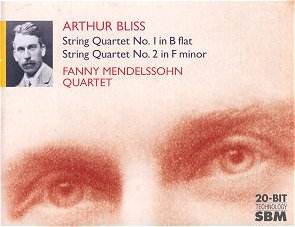Renate Eggebrecht-Kupsa's Troubadisc
label has a small and select chamber music catalogue. It spans several
multi-disc series including Reger chamber works with piano and three
cunningly arranged Milhaud string quartet/song discs. In addition there
are four Ethel Smyth CDs (one in a double volume), and one disc apiece
for quartets by Tailleferre, Grazyna Bacewicz and Gloria Coates (the
latter complementing the recent Naxos USA release reviewed elsewhere
on this site). Their Fanny Mendelssohn lieder series has just been launched
and then there is this Bliss disc.
The First Quartet dates from Bliss's years in
the USA. These years straddled the start of the Second World War when
Bliss was in the States on a lecture tour. His return came about when
Boult invited him back to a senior position in the BBC. The Quartet
(which like the second quartet is in four movements) was premiered by
the Pro Arte Quartet at UCB on 9 April 1941. The UK premiere was by
the Grillers at one of the famed wartime concerts at the National Gallery,
London on 27 March 1942. It was the Grillers who gave the first performance
of the Second Quartet at the naissant Edinburgh Festival on 1 September
1950. They also recorded the quartet for Decca.
Bliss's string writing is very distinctive, harmonically
rich and at times athletic. He does not veer into pastoral musing but
he is often soulful. The First Quartet has many similarities with the
Bliss's Music for Strings (premiered by Boult in Vienna in 1935).
The music goes with a great sense of yearning passion and a swing. Once
or twice I was also reminded of the Bliss Violin Concerto written for
Alfredo Campoli and played with ferocious virtuosity by John Georgiadis
in a 1975 BBC studio performance alongside the Metamorphic Variations.
The Second Quartet was said by the composer
to be his best work in chamber music. He also wrote of his ambition
'to try for an emotion truly and clearly felt and caught forever in
formal perfection.' He attains this in the hushed breathlessness of
the brief sostenuto. This is the track to play to sceptics and
'non-believers' and I think it works a shade better on the Troubadisc
than on the Hyperion. The first movement is rather unremittingly active
but the vivo e con brio works well with some Italianate relaxation
suggestive of Walton's violin concerto. This is a work of greater complexity
than the 1941 work and I am not at all sure that it works as well as
the more straight-talking First Quartet. The first two movements struck
me as having been influenced somewhat by Britten.
The quartet includes Renate Eggebrecht-Kupsa (1st violin)
who is proprietor of Troubadisc, her husband, Friedeman Kupsa (cello),
Mario Korunic (2nd violin) and Stefan Berg (viola). They were founded
in 1986 on the occasion of the performance of Fanny-Mendelssohn-Hensel's
String Quartet in E flat major and Piano Quartet in A flat Major.
The thorough and extensive Troubadisc notes are by
British Music Society member, Meinhard Saremba. They are in German and
in fluent English translation by George J Low.
The competition comes from a Hyperion disc with the
Delmé (CDA66178). That was made a decade earlier in March 1985.
The notes there are by Bliss's friend, the music critic, George Dannatt
(also the dedicatee of Bliss's last major orchestral work, Metamorphic
Variations). The Delmé tend to take things more slowly than
the Mendelssohns - 12.02 in movement IV of the second quartet as against
9.49 on Troubadisc. The Hyperion plays for 64.44 against the Troubadisc
57.48. There is otherwise little to choose between them except in relation
to microphone placement. The Troubadisc engineers seem to have placed
the microphones closer to the players than the Hyperion team producing
a more dazzlingly lit effect.
These are Bliss's only numbered quartets. There are
two others (unnumbered) - one from 1914 and an incomplete one from 1923-4.
It is a pity that one or other of these could not have joined the two
here. There are quite a few early Bliss chamber works that surely merit
recording.
Rob Barnett


